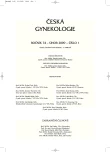The lifestyle of Pilsner University female students and its effect on vaginal mycosis
Authors:
M. Čedíková; L. Černá; Z. Ulčová-Gallová; K. Bibková; A. Hodinová; Z. Mičanová
Authors‘ workplace:
Gynekologicko-porodnická klinika LF UK a FN, Plzeň, přednosta doc. MUDr. Z. Rokyta, CSc.
Published in:
Ceska Gynekol 2009; 74(1): 27-30
Overview
Background:
Up to now, it does not exit whole look at the life quality of the Pilsner female University students, especially in connection with gynecological history. It is reality that in last years the number of gynecological problems among young women increases such as the number of diseases with immunological background.
Method:
We prepared questionnaire with 36 questions directed to life style, gynecological history, partner’s life, food and hygienic habits, and nicotinism.
Results:
28 female students from the total group of 141 suffered from vaginal mycosis – 22 (78.6%) use pills, 6 (21.4%) no hormonal contraception. 17 (60.7%) prefer flyaway cloth and 9 (32.1%) tight cloth. 141 students mentioned various number (0-25) of their sexual partners: 1-3 (79 students) in 15 cases (19%) mycoses, more than 4 partners (49 students) in 13 (26.5%) mycoses appeared. The first menstruation appeared in o 13 years (10-17 years). High incidence of vaginal mycosis was proven in students using only tampons than hygienic towels.
Conclusion:
Vaginal mycosis is affected by many endogenous and exogenous factors. The main factors in pilsner university female students are hormonal contraception, promiscuity and hygienic habits.
Key words:
mycotic diseases, hormonal contraception, university students, promiscuity
Sources
1. Bradshaw, CS., Morton, AN., Garland, SM., et al. Higher - risk behavioral practices associated with bacterial vaginosis compared with vaginal candidiasis. Obstet Gynecol, 2005, 106, 1, p. 105-114.
2. Čepický, P., Malina, J., Kuzelová, M. Léčba aerobní vaginitidy a klinicky nejisté příčiny vulvovaginálního diskomfortu. Čes Gynek, 2003, 68, 6, s. 439-442.
3. Ferrer, J. Vaginal candidosis: epidemiological and etiological factors. Int J Gynaecol Obstet,, 2000, 71, 1, p. 21-27.
4. Fosch, S., Fogolín, N., Azzaroni, E., et al. Vulvovaginitis: correlation with predisposing factors, clinical manifestations and microbiological studies. Rev. Argent Microbiol, 2006, 38, 4, p. 202-205.
5. Lebedeva, OP., Kalutski?, PV. Anti-infectious defense of vagina during use of low-dose monophasic contraceptives. Zh Mikrobiol Epidemiol Immunobiol, 2007, 1, p. 67-70.
6. Líbalová, Z., Čepický, P., Malina, J., et al. Doporučení pro diagnózu a terapie vulvovaginitidy. Čes Gynek, 2002, 67, 2, s. 97-100.
7. Pumpianski, R., Ganor, S. Vulvovaginal candidosis and oral contraceptives. Mykosen, 1974, 17, 8, p. 173-178.
8. Unzeitig, V., Bucek, R., Al Awad, H. Vaginání bakteriologie u žen užívajících vložky a tampony během menstruace. Čes Gynek, 2007, 72, 6, s. 416-419.
Labels
Paediatric gynaecology Gynaecology and obstetrics Reproduction medicineArticle was published in
Czech Gynaecology

2009 Issue 1
Most read in this issue
- Thyroid gland in the gravidity
- Spontaneous symphysis pubis rupture followed by intraabdominal bleeding during the vaginal delivery
- The diagnostic value of hysterosalpingography in the diagnosis of tubal disease
- News in pathophysiology and management of preterm labour
